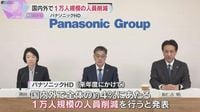On May 9, 2025, Panasonic Holdings Corporation announced a significant restructuring initiative that will see a workforce reduction of 10,000 employees across its global operations. This decision comes as part of the company's broader strategy to enhance operational efficiency and address unprofitable business segments.
The firm plans to cut approximately 5,000 jobs domestically in Japan and another 5,000 overseas, primarily targeting its consolidated subsidiaries. This workforce reduction is expected to be implemented by March 2026, with the company anticipating a loss of 130 billion yen in the current fiscal year due to the associated structural reform costs.
During a press conference, President Yuki Kusumi acknowledged the gravity of the situation, stating, "The responsibility for the personnel reduction rests with me," and announced he would return about 40% of his total compensation for the term as part of his accountability. He expressed his reluctance regarding the layoffs, saying, "It is with great regret that we must address areas where labor productivity is not necessarily high." Kusumi emphasized the necessity of these changes to ensure sustainable growth over the next decade.
As of the end of March 2025, Panasonic's consolidated workforce stood at approximately 207,548 employees, meaning the planned cuts will affect about 4.8% of its total workforce. The company has cited the expansion of indirect departments, such as general affairs and human resources, as a contributing factor to its sluggish business performance, prompting the need for a streamlined operational structure.
In addition to workforce reductions, Panasonic is also focusing on withdrawing from unprofitable business sectors, consolidating its operational bases, and restructuring its home appliance division. These measures are part of a larger plan aimed at achieving an adjusted operating profit of over 600 billion yen by the fiscal year ending in March 2027. This goal reflects a projected profit improvement of 150 billion yen compared to fiscal year 2024.
The company expects that structural reforms will improve profits by 122 billion yen. This figure includes 70 billion yen from optimizing personnel, 47 billion yen from reforms at the head office, 33 billion yen from changes in the home appliance sector, and 42 billion yen from restructuring various business divisions.
Despite the anticipated losses, Kusumi remains optimistic about Panasonic's future, noting that the company is committed to investing in growth areas such as vehicle batteries and other priority sectors. He indicated that the company would continue to manage its business portfolio actively, aiming for a comprehensive improvement in profitability.
Analysts have expressed concern regarding Panasonic's financial outlook. The company forecasts a consolidated net profit of 310 billion yen for the current fiscal year, marking a 15.3% decrease from the previous year. This figure falls short of the average forecast of 360.7 billion yen from 15 analysts compiled by I/B/E/S, highlighting the challenges the company faces as it navigates this transitional period.
Panasonic's restructuring efforts echo a similar initiative from the early 2000s when the company, then known as Matsushita Electric Industrial Co., Ltd., implemented a voluntary retirement program that resulted in approximately 13,000 job cuts following the burst of the IT bubble. However, unlike that period of significant financial loss, Panasonic is currently profitable, aiming to establish a more sustainable business model.
As part of its response to external economic pressures, including the impact of U.S. tariff policies, Panasonic has stated that it plans to address increased costs primarily through price adjustments. Should these price increases fail to cover the additional costs, the estimated impact on adjusted operating profit is expected to be less than 1% of consolidated sales revenue.
Kusumi also commented on the demand for vehicle batteries produced in Japan and the U.S., stating that there has been no significant drop in demand from major automotive clients, even amid concerns regarding tariffs. He speculated that the current challenges faced by Chinese battery manufacturers might prevent a substantial decrease in demand from Panasonic's key customers over the next year.
In conclusion, Panasonic Holdings' decision to reduce its workforce and restructure its operations reflects a critical effort to adapt to changing market conditions and improve overall profitability. As the company embarks on this ambitious reform process, stakeholders will be watching closely to see how these changes will impact its long-term growth trajectory and market position.






